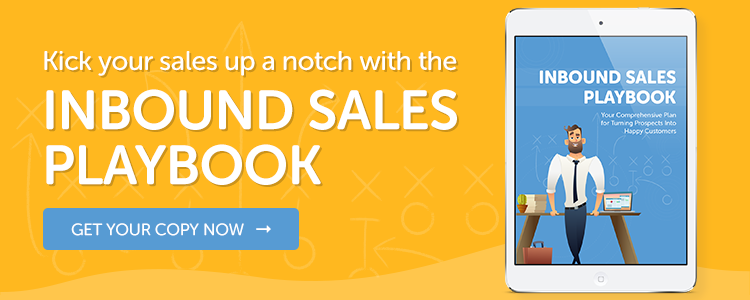In any technology-focused industry, it’s important to continuously build new skills.
Companies that do business online need to embrace that culture of continuous improvement, too. Conventional wisdom in sales, marketing, and operations should be constantly re-evaluated.
That is especially true if you want to prepare your enterprise to do things the inbound way.
Inbound sales refers to a sales process that kicks into gear when leads signal interest and, typically, contact your sales team on their own accord. Inbound sales pros work with inbound marketers, who produce online content that educates leads and creates a relationship.
An inbound approach is simply more effective for today’s buying decision maker for several reasons:
- It avoids interruptive methods, such as cold calling, that most B2B buyers actively avoid.
- It gives leads the power to decide the pace of the product research and selection process.
- It allows you to position yourself as a trusted, value-added adviser to your prospective customers.
Customers expect businesses they trust to work the inbound way – whether they call it that or not. In a world where they enjoy huge amounts of product information at their fingertips, fewer decision makers have time for pushy sales pros who might not have their interests at heart.
Why Do Some Sales Organizations Struggle to Adopt Inbound Sales?
Since inbound flips conventional sales wisdom on its head, it can be a challenge for some sales teams to switch over. Sales pros with years of experience with outbound sales may be leery of a new approach for many reasons – not least that they are already producing results “their way.”
Some of the most common objections to inbound sales include:
- “Things are still working the old way, so why change now?”
- “Other new ideas about sales have come and gone before.”
- “We don’t have the time, technology, or resources to change.”
Let’s look at these objections and how they stack up:
“Things are still working the old way, so why change now?”
No doubt about it – some companies might still be getting occasional results with outbound. As time goes on, those results will be increasingly marginal.
Inbound sales isn’t change for change’s sake: It’s a reflection of how modern customers and leads want to be treated.
“Other new ideas about sales have come and gone before.”
This is true, but it doesn’t reflect a deep understanding of how inbound sales contributes to growth.
Inbound isn’t just a new sales tactic, like cold calling. It’s not even a framework, like consultative selling. It’s a completely new sales philosophy fully aligned with today’s buyer journey.
“We don’t have the time, technology, or resources to change.”
Of course, any change management program is hard work. That said, making the change is easier than it looks.
It’s surprisingly cost effective: For example, you can use the free HubSpot CRM to automate many inbound sales workflows. Mostly, you’ll be changing processes, not tools.
It may take a quarter or two to get up and running with inbound sales, but it’s worth it. Being among the first companies in your market with mature inbound processes will make you much more competitive in the future.
To begin, meet your sales pros where they are now.
Four Ways to Start Sales Pros on the Road to Inbound Sales Success

1. Start With the Data on Your Side
Sales professionals understand results. Data and numbers can help you persuade them on how effective inbound selling truly is.
Take this one for example: Cold calling has a 2.5% success rate. On the other hand, when IBM implemented an inbound social selling program, it increased sales by a whopping 4000%.
These numbers are impressive. Be aware of the story behind them, too: Once sales experts realize they won’t lose budget or prestige over a switch to inbound, they are usually much more enthusiastic. Hard stats prove their results are likely to improve.
Also, you should make content about inbound selling available to your salespeople. Meet, brainstorm, and yes – find out what objections you need to address. Making major changes means winning buy-in, too.
2. Pilot Inbound Sales in Your Organization
Hard hitting stats can convince skeptics, but nothing speaks as loudly as experience.
With the right tools and techniques, you can pilot inbound selling with a single representative. Again, a CRM is essential: It empowers one person to do the work of many by giving complete visibility into the buyer's journey for multiple leads at a time.
Experienced sales leaders and young, energetic newcomers can do great work with a pilot program. Give your “pilots” permission to experiment – and even to fail – before judging results. It often takes about a quarter to get numbers moving in the right direction.
With proven results on your side, it’s easier to find an executive sponsor who’ll support further work based around the inbound model. Pretty soon, your enterprise will have a running start on inbound.
3. Find Ways for Sales and Marketing to Work Together
Firms that succeed best with inbound have strong partnerships between sales and marketing.
Even if you’re not going whole hog on inbound right away, it’s still a good idea for sales and marketing to be collaborators rather than competitors. Both teams have insights the other can use.
For example, sales pros are usually the first to encounter new quirks in customer thinking. The objections people raise with them can help marketing teams craft their digital content strategy.
By providing the lowdown on the path leads took through the company website and other properties, marketing teams can inform sales discovery calls. They can also ensure qualifying details collected online are forwarded promptly to the relevant sales contact.
4. Begin Automating Sales Processes Early On
No matter what model of sales you bank on, automating processes saves you time and money.
There are many ways you can get started with automation:
- Integrate CRM software into your email, phone contacts, and web analytics.
- Ensure seamless lead scoring is keeping you appraised of key website activity.
- Use social prospecting software to help you verify leads and warm them up.
The fewer manual processes you need to deal with, the easier it’ll be for your teams to stay focused on best-fit customers and high-level tasks. That also leaves them with more energy for their interactions with leads – where they have the best opportunity to build rapport.
Plus, if you decide to make the jump to inbound selling, you’ll have fewer details to worry about.
Sales Pros Shouldn’t Fear Inbound: It Means Lasting, Successful Customer Relationships
Once misconceptions about inbound sales are dealt with, most team members see the value.
In fact, value is what it’s all about:
- You provide value to leads and foster trust before the sale is even made.
- They provide value to you by giving you deeper insight into their needs.
- You both get value from long-term, lucrative deals with lower turnover.
- Sales pros can consistently stretch themselves and expand their skills.
When you adopt inbound sales, nobody loses and everybody wins. That may come as a surprise to some raised in outbound selling – inbound is cooperative, not “cutthroat.”
The change in mentality is well worth it: In the end, inbound sales means less stress and more time doing things that move you and your customers toward success.


Rob Steffens
I am the Director of Marketing here at Bluleadz. I'm a huge baseball fan (Go Yankees!). I love spending time with friends and getting some exercise on the Racquetball court.